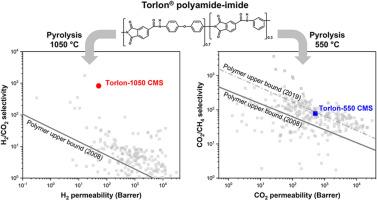Torlon®聚酰胺-亚胺:碳分子筛气体分离膜的多功能前驱体
IF 9
1区 工程技术
Q1 ENGINEERING, CHEMICAL
引用次数: 0
摘要
虽然碳分子筛(CMS)膜具有很强的气体分离性能,但不同的聚合物前体需要制备不同的CMS膜来进行不同的分离。例如,通常需要具有低分数自由体积的前驱体(例如聚酰胺和聚苯并咪唑)来制造具有吸引力的H2/CO2选择性的CMS膜,而由更开放的前驱体(例如基于6fda的聚酰亚胺)制成的CMS膜更适合分离较大的CO2/CH4对。这是非常理想的,以确定一个多功能前体,可以使CMS膜吸引更广泛的气体分离通过简单的控制热解条件。在这项工作中,我们证明了在高温混合物渗透下,Torlon®聚酰胺-亚胺的高温热解得到了具有超高稳定的H2/CO2选择性的新型CMS膜。我们还发现Torlon是一种多功能前驱体,可以使CMS膜在低热解温度下表现出良好的CO2/CH4分离性能。对CMS膜孔结构的研究表明,Torlon的酰胺-亚胺共聚物骨架是其作为CMS膜前体的多功能性的原因。本文章由计算机程序翻译,如有差异,请以英文原文为准。

Torlon® polyamide-imide: A versatile precursor for carbon molecular sieve gas separation membranes
While carbon molecular sieve (CMS) membranes have shown highly competitive gas separation properties, different polymer precursors are required to fabricate CMS membranes for different separations. For example, precursors with low fractional free volume (e.g., polyamide and polybenzimidazole) are often needed to fabricate CMS membranes with attractive H2/CO2 selectivity, whereas CMS membranes made from more open precursors (e.g., 6FDA-based polyimides) are more suitable to separate the larger CO2/CH4 pair. It is highly desirable to identify a versatile precursor that can give CMS membranes attractive for a wider spectrum of gas separations by simple control of pyrolysis conditions. In this work, we show that high-temperature pyrolysis of Torlon® polyamide-imide gives new CMS membranes with ultra-high and stable H2/CO2 selectivity under high-temperature mixture permeation. We also found Torlon is a versatile precursor that can give CMS membranes showing attractive CO2/CH4 separation performance at low pyrolysis temperature. An investigation of CMS membrane pore structures suggested that Torlon's amide-imide copolymer backbone was responsible for its versatility as a CMS membrane precursor.
求助全文
通过发布文献求助,成功后即可免费获取论文全文。
去求助
来源期刊

Journal of Membrane Science
工程技术-高分子科学
CiteScore
17.10
自引率
17.90%
发文量
1031
审稿时长
2.5 months
期刊介绍:
The Journal of Membrane Science is a publication that focuses on membrane systems and is aimed at academic and industrial chemists, chemical engineers, materials scientists, and membranologists. It publishes original research and reviews on various aspects of membrane transport, membrane formation/structure, fouling, module/process design, and processes/applications. The journal primarily focuses on the structure, function, and performance of non-biological membranes but also includes papers that relate to biological membranes. The Journal of Membrane Science publishes Full Text Papers, State-of-the-Art Reviews, Letters to the Editor, and Perspectives.
 求助内容:
求助内容: 应助结果提醒方式:
应助结果提醒方式:


